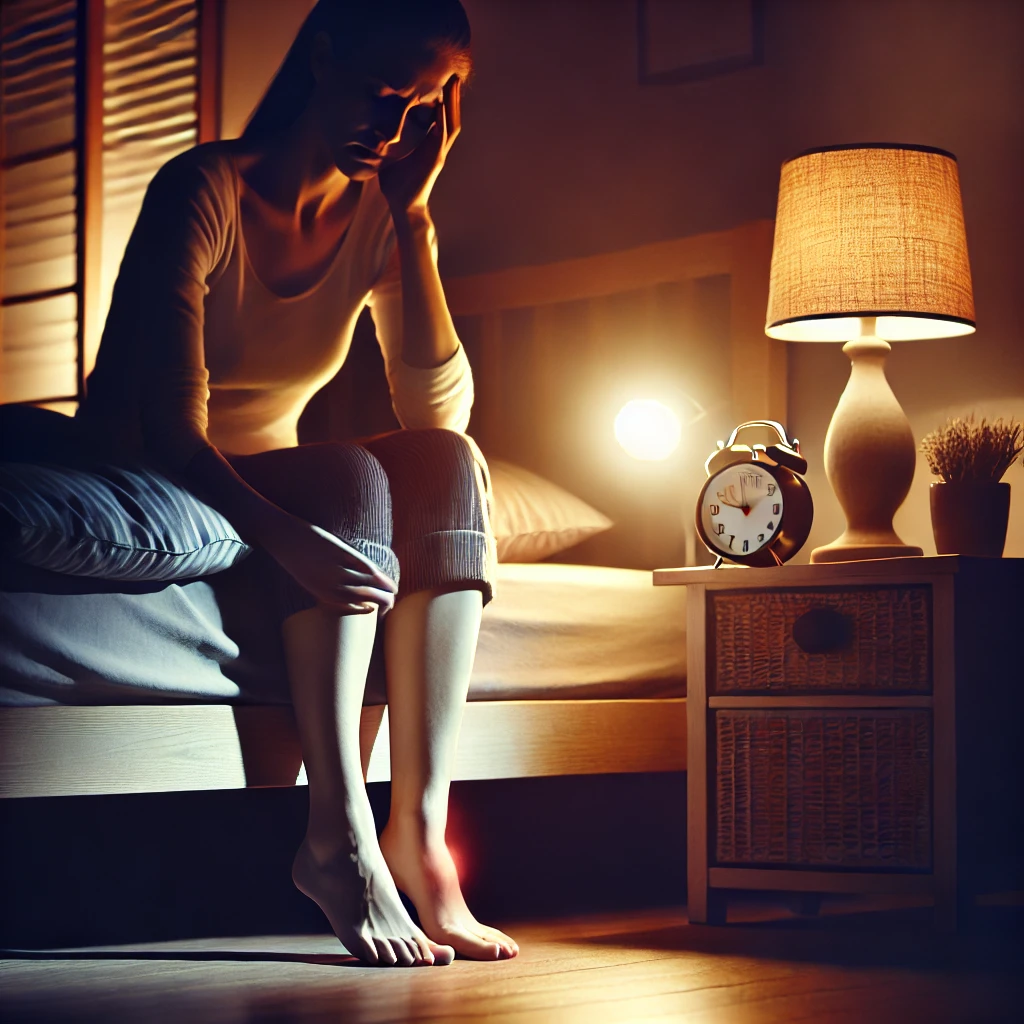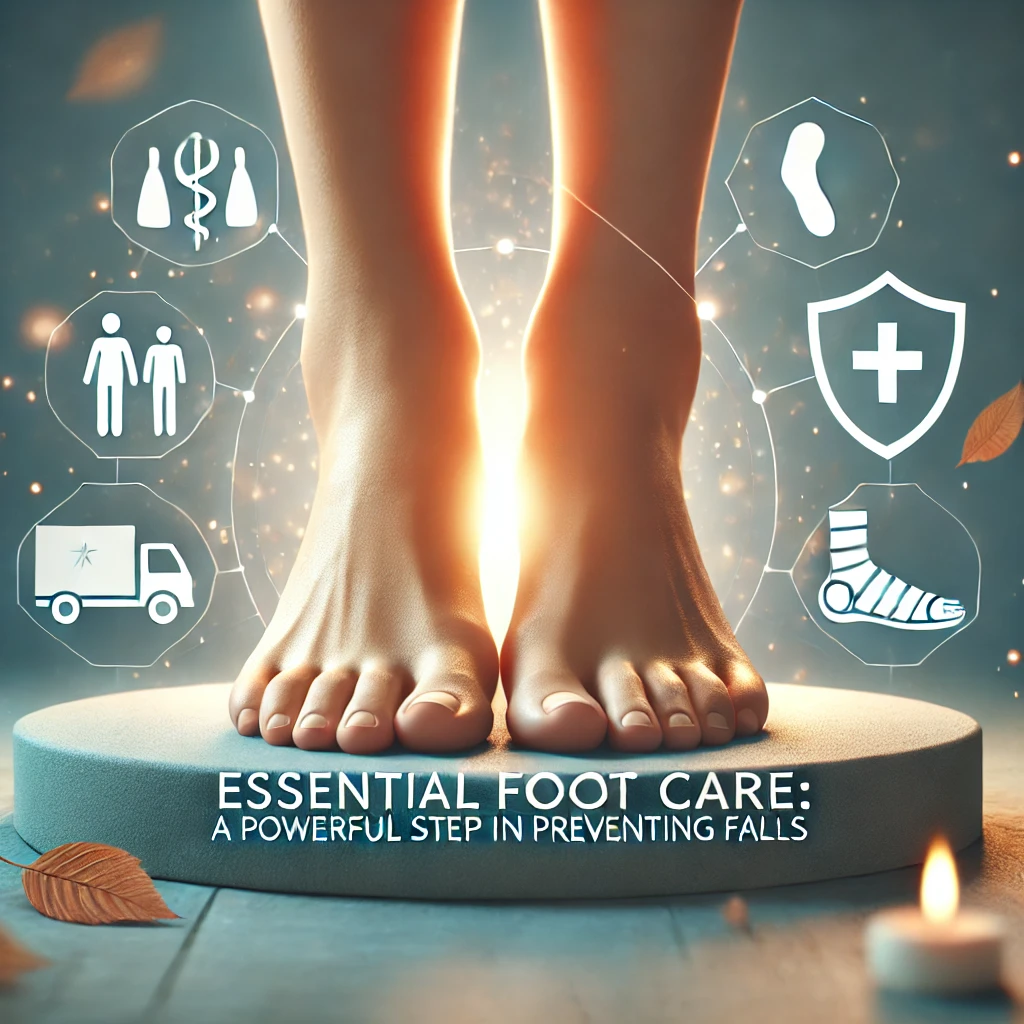Introduction
Do you find yourself tossing and turning at night because of aching feet? You’re not alone! Foot problems can significantly impact sleep quality, making it difficult to fall asleep or stay asleep throughout the night. Since our feet bear the weight of our entire body during the day, it’s no surprise that they can develop aches, pains, and conditions that carry into our rest time.
Many people don’t realize how closely linked foot health and sleep are. Whether it’s persistent pain, restless sensations, or circulatory issues, foot problems can trigger sleep disturbances that lead to fatigue, irritability, and even long-term health concerns. But why does this happen? And more importantly, what can you do about it?
In this article, we’ll explore the connection between foot problems and sleep, the most common foot-related sleep disruptors, and effective ways to find relief. If you’ve ever wondered why your feet keep you up at night, keep reading!
The Relationship Between Foot Health and Sleep

Your feet play a crucial role in maintaining overall balance and movement. But beyond just getting you from place to place, they can also affect the quality of your sleep. Here’s how:
- Pain Disrupts Sleep Cycles – Chronic foot pain can prevent deep sleep by causing discomfort that makes it hard to relax.
- Neurological Links – The nerves in your feet are connected to the nervous system, meaning pain or tingling can lead to restlessness.
- Common Sleep Issues – Conditions like foot cramps, tingling sensations, and poor circulation can all interfere with your ability to fall and stay asleep.
When foot pain is ignored, it often leads to poor sleep, which then worsens pain perception and fatigue—a frustrating cycle that’s tough to break.
Common Foot Problems That Affect Sleep

Several foot conditions can make sleeping comfortably a challenge. Here are some of the most common culprits:
Plantar Fasciitis
This painful condition causes stabbing pain in the heel and arch, often worst in the morning but sometimes flaring up at night. The inflammation can make it difficult to find a comfortable sleeping position.
Neuropathy
Nerve damage, often associated with diabetes, can cause tingling, burning, or numbness in the feet, making it hard to relax. These sensations tend to worsen at night.
Restless Leg Syndrome (RLS)
This condition causes an irresistible urge to move the legs, often accompanied by an uncomfortable tingling or crawling sensation in the feet. It’s a major cause of sleep disturbances.
Arthritis and Joint Pain
Arthritis in the feet can lead to stiffness and pain that worsens at night due to inflammation and lack of movement.
Bunions and Foot Deformities
Foot deformities can create pressure points that make sleeping positions uncomfortable, leading to frequent awakenings.
If any of these conditions sound familiar, they could be the reason behind your sleepless nights.
How Foot Pain Affects Sleep Quality
Foot pain can turn a good night’s sleep into a struggle. Here’s how it interferes with rest:
- Difficulty Falling Asleep – Persistent pain or discomfort can keep your mind and body too alert to fall asleep.
- Nighttime Awakenings – Sudden foot cramps, tingling, or pain can wake you up multiple times during the night.
- Reduced REM Sleep – Foot pain can prevent deep, restorative sleep cycles, leaving you feeling tired even after a full night in bed.
- Chronic Sleep Deprivation – Long-term sleep disruption due to foot pain can lead to increased stress, fatigue, and even a weakened immune system.
Getting to the root of the problem is essential for improving sleep quality.
The Role of Poor Circulation in Sleep Disruptions
Poor circulation is another factor that can cause foot discomfort at night. When blood flow is restricted, it can lead to:
- Cold Feet – Lack of circulation can make feet feel icy and uncomfortable.
- Numbness and Tingling – Reduced blood flow can cause feet to “fall asleep” and create a tingling sensation.
- Pain and Cramping – Insufficient oxygen to the muscles can result in painful cramps, particularly at night.
Conditions like diabetes and peripheral artery disease (PAD) can contribute to circulation problems, making foot discomfort even worse.
Restless Leg Syndrome (RLS) and Sleep Disruptions
Restless Leg Syndrome (RLS) is one of the most frustrating conditions that can affect your sleep. It creates an uncontrollable urge to move your legs, often accompanied by tingling, itching, or even painful sensations in the feet.
What Causes RLS?
The exact cause of RLS isn’t fully understood, but it’s believed to be linked to:
- Dopamine imbalances – A deficiency in dopamine, a neurotransmitter that helps regulate movement, can contribute to RLS symptoms.
- Iron deficiency – Low iron levels are associated with an increased risk of RLS.
- Chronic diseases – Conditions like diabetes, kidney disease, and peripheral neuropathy can increase RLS symptoms.
- Medications – Some antihistamines, antidepressants, and antipsychotic drugs may trigger or worsen RLS.
How RLS Disrupts Sleep
- Increased nighttime restlessness – The discomfort typically worsens when lying down, making it hard to relax.
- Difficulty staying still – Frequent leg movements can prevent you from falling into deep sleep.
- Daytime fatigue – Poor sleep quality due to RLS can result in tiredness, mood swings, and reduced concentration.
Managing RLS for Better Sleep
- Iron supplements – If you have an iron deficiency, supplementing may help reduce symptoms.
- Stretching exercises – Light leg stretches before bed can ease discomfort.
- Avoiding caffeine and alcohol – These substances can make RLS worse.
- Warm baths and massages – Relaxing the muscles may help reduce nighttime restlessness.
If RLS is severe, a doctor may prescribe medications to help regulate dopamine and improve sleep quality.
How Diabetes-Related Foot Problems Impact Sleep
People with diabetes often experience foot problems that interfere with sleep. Diabetic neuropathy, a condition that causes nerve damage in the feet, is a common culprit.
Symptoms of Diabetic Neuropathy
- Burning or tingling sensations – Many diabetics feel a burning sensation in their feet, especially at night.
- Numbness or loss of sensation – This can lead to difficulty detecting injuries, increasing the risk of complications.
- Sharp pain – Shooting pains may occur randomly, making it difficult to sleep peacefully.
Why Diabetes Makes Foot Pain Worse at Night
- Reduced blood circulation – Diabetes can lead to poor circulation, especially when lying down.
- Increased nerve sensitivity – Nerves can become hypersensitive to touch, temperature, and pressure.
- Higher risk of foot infections – Slow wound healing and infections can contribute to pain and discomfort.
Tips for Managing Diabetic Foot Pain at Night
- Keep blood sugar levels stable – Proper diabetes management helps prevent nerve damage.
- Wear compression socks – These can improve circulation and reduce discomfort.
- Use pain-relief creams – Topical treatments containing capsaicin or menthol can help numb pain.
- Maintain proper foot hygiene – Washing and moisturizing feet regularly can prevent dryness and cracks that worsen pain.
If diabetic neuropathy becomes severe, medical interventions such as prescription pain relievers or nerve therapy may be necessary.
Foot Cramps and Their Impact on Sleep
Waking up with a sudden foot cramp can be incredibly painful and disrupt your sleep. These cramps occur when muscles in the foot tighten involuntarily, causing a sharp, intense pain.
Causes of Nighttime Foot Cramps
- Dehydration – Lack of fluids can lead to muscle cramps.
- Mineral deficiencies – Low levels of potassium, calcium, or magnesium can trigger cramps.
- Overuse of foot muscles – Standing for long periods or excessive exercise can cause fatigue-related cramps.
- Poor circulation – Restricted blood flow can contribute to cramping.
How to Prevent Foot Cramps at Night
- Stay hydrated – Drinking enough water throughout the day can reduce the likelihood of cramps.
- Stretch before bed – Gentle foot and calf stretches can relax muscles.
- Increase electrolyte intake – Consuming bananas, dairy products, or leafy greens can help balance mineral levels.
- Massage the feet – Rubbing the affected area can increase circulation and relieve tension.
Applying heat or using magnesium supplements may also help prevent frequent cramps.
The Connection Between Foot Temperature and Sleep
Temperature regulation is key to a good night’s sleep, and your feet play an important role. If your feet are too hot or too cold, it can make falling asleep difficult.
Cold Feet and Sleep Disruptions
When feet are cold, blood vessels constrict, reducing circulation and making it harder to relax. This can cause discomfort and prolong the time it takes to fall asleep.
Solutions for Cold Feet at Night:
- Wear warm socks – Thermal socks can help maintain warmth.
- Use a heated blanket – Placing a heating pad at the foot of the bed can keep your feet cozy.
- Take a warm foot bath before bed – This can improve circulation and prepare your body for sleep.
Overheated Feet and Sleep Problems
On the flip side, having hot, sweaty feet can also disrupt sleep by causing discomfort and restlessness.
Solutions for Overheated Feet:
- Avoid heavy blankets – Opt for breathable bedding materials.
- Sleep with feet outside the covers – Exposing your feet can help regulate body temperature.
- Use moisture-wicking socks – These can help absorb sweat and keep your feet cool.
Best Sleeping Positions for Foot Pain Relief
How you sleep can affect foot pain and overall comfort. Certain positions may put extra pressure on the feet, worsening discomfort.
Recommended Sleeping Positions:
- Elevate your feet – Placing a pillow under your feet can improve circulation and reduce swelling.
- Sleep on your back – This position reduces pressure on the feet and keeps them aligned properly.
- Use a body pillow – A body pillow can support the legs and prevent unnecessary movement that may aggravate pain.
Sleeping Positions to Avoid:
- Sleeping on your stomach – This can strain the ankles and lead to discomfort.
- Crossing your legs – This may worsen circulation issues and cause tingling sensations.
Using supportive pillows or an adjustable bed frame can further help with foot pain relief.
Choosing the Right Footwear for Better Sleep
Wearing the wrong shoes during the day can lead to nighttime foot discomfort.
Footwear Mistakes That Cause Sleep Issues:
- Wearing shoes with poor arch support – This can lead to plantar fasciitis and pain at night.
- Using tight or narrow shoes – These can cause bunions and nerve compression.
- Walking barefoot on hard surfaces – This can strain the feet and increase sensitivity.
Best Footwear Choices for Foot Pain Prevention:
- Supportive arch shoes – These provide proper alignment and cushioning.
- Orthopedic slippers – Ideal for wearing indoors to prevent strain.
- Compression socks – Help improve circulation and reduce swelling.
Investing in the right footwear can make a big difference in both daytime comfort and nighttime sleep quality.
Home Remedies for Foot Pain and Better Sleep
If foot pain is keeping you up at night, some simple home remedies may provide relief. These natural solutions can ease discomfort and help you sleep better.
Warm Foot Soaks and Epsom Salt Baths
A warm foot soak before bed can relax sore muscles and improve circulation. Adding Epsom salt (rich in magnesium) can further ease muscle tension and reduce inflammation.
How to do it:
- Fill a basin with warm water.
- Add half a cup of Epsom salt.
- Soak your feet for 15–20 minutes.
- Pat dry and apply moisturizer to prevent dryness.
Massage Techniques for Foot Relaxation
Massaging your feet before bed can relieve tension and improve blood flow. Using essential oils like peppermint, eucalyptus, or lavender can enhance relaxation.
Self-massage tips:
- Use gentle circular motions on the soles and arches.
- Apply pressure to pressure points (such as the ball of the foot) to ease pain.
- Use a tennis ball or a foot roller for a deep tissue massage.
Stretching Exercises to Relieve Foot Pain
Performing simple stretches before bed can reduce stiffness and cramps.
Effective Foot Stretches:
- Toe stretch – Pull your toes back gently to stretch the arch.
- Calf stretch – Stand against a wall and stretch your calves to relieve tension in the heels.
- Ankle rolls – Rotate your ankles in circular motions to improve flexibility.
Medical Treatments for Chronic Foot Pain
If home remedies aren’t enough, medical treatments may be necessary for chronic foot pain.
When to See a Doctor
Seek medical attention if you experience:
- Persistent foot pain lasting more than two weeks.
- Numbness or tingling that affects daily activities.
- Severe swelling or inflammation.
- Difficulty walking or bearing weight on your foot.
Pain Management Options
Doctors may recommend the following treatments based on the cause of your foot pain:
1. Orthotics and Medical Devices
- Custom shoe inserts – Provide arch support and cushioning.
- Night splints – Help stretch the plantar fascia and reduce morning pain.
- Compression socks – Improve blood circulation and reduce swelling.
2. Medications
- Pain relievers – Nonsteroidal anti-inflammatory drugs (NSAIDs) like ibuprofen can help.
- Topical creams – Lidocaine or capsaicin creams can provide localized pain relief.
- Prescription medications – For severe cases, doctors may prescribe stronger painkillers or nerve medications.
3. Physical Therapy
- A physical therapist can provide specialized exercises and treatments to reduce foot pain and improve mobility.
4. Surgery (For Severe Cases)
- If foot deformities or chronic conditions like severe bunions, arthritis, or plantar fasciitis don’t respond to treatments, surgery may be necessary.
Lifestyle Changes to Improve Sleep and Foot Health
Making small changes to your lifestyle can improve both foot health and sleep quality.
Diet and Hydration for Healthy Feet
- Drink plenty of water – Staying hydrated prevents muscle cramps.
- Increase magnesium intake – Found in leafy greens, nuts, and seeds, magnesium helps relax muscles.
- Consume omega-3 fatty acids – Fish, flaxseeds, and walnuts help reduce inflammation.
The Role of Exercise in Foot Pain Prevention
Regular movement can strengthen foot muscles and prevent stiffness.
Best exercises for foot health:
- Walking
- Swimming
- Yoga
- Resistance band exercises for the feet
Sleep Hygiene for Better Rest
- Stick to a consistent bedtime to regulate sleep cycles.
- Reduce screen time before bed to avoid blue light exposure.
- Keep your bedroom cool, dark, and quiet for optimal sleep.
Making these adjustments can create a long-term improvement in both your foot health and sleep patterns.
Conclusion
Foot problems can have a significant impact on sleep, leading to discomfort, frequent awakenings, and poor rest quality. Conditions like plantar fasciitis, neuropathy, restless leg syndrome, and poor circulation can make falling and staying asleep a challenge. However, understanding the link between foot health and sleep allows you to take steps toward relief.
By practicing home remedies, improving footwear choices, and adopting a foot-friendly lifestyle, you can reduce pain and improve sleep quality. If foot pain becomes chronic, seeking medical advice is essential to prevent long-term complications.
Taking care of your feet doesn’t just improve mobility—it also helps you sleep soundly at night.
Frequently Asked Questions
1. Why do my feet hurt more at night?
Foot pain tends to worsen at night due to reduced circulation, nerve sensitivity, and lack of movement. Conditions like plantar fasciitis, neuropathy, or arthritis may also contribute to night time discomfort.
2. Can poor footwear cause sleep problems?
Yes, wearing unsupportive or tight shoes during the day can lead to foot pain that persists at night, affecting sleep quality. Choosing properly cushioned and supportive footwear can prevent discomfort.
3. What is the best sleeping position for foot pain?
Sleeping on your back with your feet elevated can help reduce swelling and improve circulation. Using a pillow for support can also relieve pressure on painful areas.
4. How can I prevent foot cramps while sleeping?
To prevent foot cramps, stay hydrated, stretch before bed, maintain adequate mineral levels (magnesium, potassium, calcium), and wear comfortable footwear.
5. When should I see a doctor for foot pain that affects my sleep?
If your foot pain persists for more than two weeks, interferes with daily activities, or is accompanied by swelling, numbness, or severe discomfort, consult a doctor for evaluation and treatment options.










